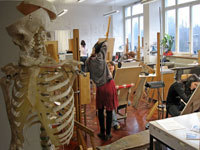UNIVERSITY OF ARTS SCIENTIFIC VISUALIZZATION

Students in Scientific Illustration must learn to develop and employ their ability in the visual presentation of knowledge both by following instructions and at their own initiative.
Not only must they be able to explain scientific findings, but they must also comply with design and aesthetic requirements.
Subjects studied
Visualization of scientific and popular scientific discoveries, notably in the fields of natural science and archaeological illustration.
Strong design skills are developed in both analogue and digital presentation media.
Structure and subjects studied
The study programme lasts three years. A preparatory and a department-specific foundation course are followed by the main course with an integrated thesis semester.
The course of study offers a broad range of subject-specific specialization areas (e.g. archaeology, medicine and biology).
General and specific modules augment one another and require specific as well as interdisciplinary forms of work.
Careers
Scientific illustrators produce documentation and illustrations for scientific and popular science purposes.
They work as employees or long-term contractors at universities, hospitals, museums, cantonal archaeology departments (in Switzerland) and historical preservation organizations.
As freelance illustrators they may perform project work on a contract basis for publishers, industrial clients or advertising agencies.
Requirements
Flexibility, a talent for observation, creativity, technical craftsmanship and entrepreneurial aptitude are the decisive factors for professional success.
Supervisor :Niklaus Heeb, Karin Seiler
Further information
Ausstellungsstrasse 60 - P.O. Box
CH – 8031 Zurich 5
Tel : +41 43 446 32 22
Fax : fax +41 43 446 45 87
Website : www.zhdk.chssv.zhdk.ch
